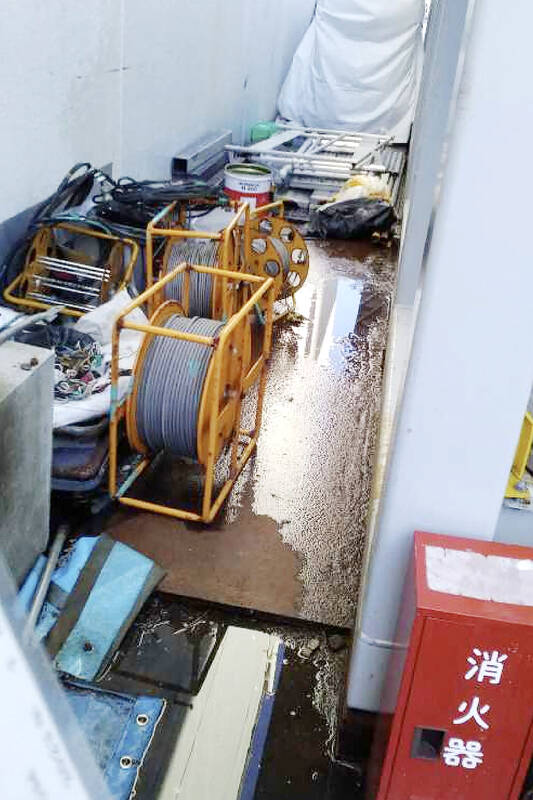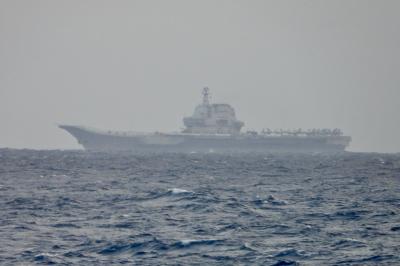An estimated 5,500 liters of radioactive water leaked from Japan’s stricken Fukushima Dai-ichi nuclear power plant but no sign of contamination has been detected outside the facility, its operator said yesterday.
A spokeswoman from Tokyo Electric Power Co (TEPCO) said that the leak was detected at part of the plant that processes contaminated water.
“We estimate that roughly 5.5 tonnes [5,500 litres] of water leaked” on Wednesday morning, but “there have been no significant changes” at posts monitoring radioactivity around the power station, she said.

Photo Tokyo Electric Power Co via AFP
Even so, TEPCO plans to remove soil from around the area that might have been contaminated, the spokeswoman said, without providing specific details on the location of the leaked water.
The Fukushima plant was wrecked by a huge earthquake and tsunami in 2011 that killed 18,000 people. It was one of the worst nuclear disasters in history.
The clean-up operation is expected to take decades, with the most dangerous part — removing radioactive fuel and rubble from three stricken reactors — yet to begin.
In August last year, Japan began gradually releasing into the Pacific Ocean 1.34 million tonnes of treated wastewater that had collected since the catastrophe, saying it is harmless and heavily diluted with seawater.
This view is backed by the UN atomic watchdog, but China and Russia have criticized the release and banned Japanese seafood imports.
Wednesday’s leak took place at a facility which processes the water before most radioactive elements are filtered out at a different, advanced facility known as ALPS.
TEPCO said the leak from a vent was spotted by a worker who was cleaning the vent before operating the facility.
“Vents should be closed during cleaning, but this time they were open,” the spokeswoman said.

US President Donald Trump yesterday announced sweeping "reciprocal tariffs" on US trading partners, including a 32 percent tax on goods from Taiwan that is set to take effect on Wednesday. At a Rose Garden event, Trump declared a 10 percent baseline tax on imports from all countries, with the White House saying it would take effect on Saturday. Countries with larger trade surpluses with the US would face higher duties beginning on Wednesday, including Taiwan (32 percent), China (34 percent), Japan (24 percent), South Korea (25 percent), Vietnam (46 percent) and Thailand (36 percent). Canada and Mexico, the two largest US trading

AIR SUPPORT: The Ministry of National Defense thanked the US for the delivery, adding that it was an indicator of the White House’s commitment to the Taiwan Relations Act Deputy Minister of National Defense Po Horng-huei (柏鴻輝) and Representative to the US Alexander Yui on Friday attended a delivery ceremony for the first of Taiwan’s long-awaited 66 F-16C/D Block 70 jets at a Lockheed Martin Corp factory in Greenville, South Carolina. “We are so proud to be the global home of the F-16 and to support Taiwan’s air defense capabilities,” US Representative William Timmons wrote on X, alongside a photograph of Taiwanese and US officials at the event. The F-16C/D Block 70 jets Taiwan ordered have the same capabilities as aircraft that had been upgraded to F-16Vs. The batch of Lockheed Martin

China's military today said it began joint army, navy and rocket force exercises around Taiwan to "serve as a stern warning and powerful deterrent against Taiwanese independence," calling President William Lai (賴清德) a "parasite." The exercises come after Lai called Beijing a "foreign hostile force" last month. More than 10 Chinese military ships approached close to Taiwan's 24 nautical mile (44.4km) contiguous zone this morning and Taiwan sent its own warships to respond, two senior Taiwanese officials said. Taiwan has not yet detected any live fire by the Chinese military so far, one of the officials said. The drills took place after US Secretary

THUGGISH BEHAVIOR: Encouraging people to report independence supporters is another intimidation tactic that threatens cross-strait peace, the state department said China setting up an online system for reporting “Taiwanese independence” advocates is an “irresponsible and reprehensible” act, a US government spokesperson said on Friday. “China’s call for private individuals to report on alleged ‘persecution or suppression’ by supposed ‘Taiwan independence henchmen and accomplices’ is irresponsible and reprehensible,” an unnamed US Department of State spokesperson told the Central News Agency in an e-mail. The move is part of Beijing’s “intimidation campaign” against Taiwan and its supporters, and is “threatening free speech around the world, destabilizing the Indo-Pacific region, and deliberately eroding the cross-strait status quo,” the spokesperson said. The Chinese Communist Party’s “threats